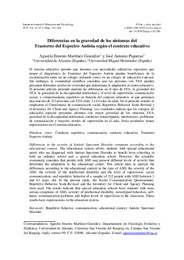Please use this identifier to cite or link to this item:
https://hdl.handle.net/11000/36005Full metadata record
| DC Field | Value | Language |
|---|---|---|
| dc.contributor.author | MARTINEZ-GONZALEZ, AGUSTIN ERNESTO | - |
| dc.contributor.author | Piqueras, Jose A | - |
| dc.contributor.other | Departamentos de la UMH::Psicología de la Salud | es_ES |
| dc.date.accessioned | 2025-03-17T09:41:42Z | - |
| dc.date.available | 2025-03-17T09:41:42Z | - |
| dc.date.created | 2019 | - |
| dc.identifier.citation | European Journal of Education and Psychology, 2019, Vol. 12, Nº 2 (Págs. 153-164) | es_ES |
| dc.identifier.issn | 1989-2209 | - |
| dc.identifier.uri | https://hdl.handle.net/11000/36005 | - |
| dc.description.abstract | El sistema educativo permite que alumnos con necesidades educativas especiales que tienen el diagnóstico de Trastorno del Espectro Autista puedan beneficiarse de la escolarización tanto en un colegio ordinario como en un colegio de educación especial. Sin embargo, la comunidad científica considera que las personas con TEA pueden presentar diferentes niveles de severidad que determinan la adaptación al centro educativo. El presente artículo pretende analizar las diferencias en el tipo de TEA, la gravedad del TEA, la gravedad de la discapacidad intelectual y el nivel de supervisión; comunicación social; y comportamiento repetitivo en función del contexto educativo al que pertenece una muestra de 232 personas con TEA entre 3 y 63 años de edad. En el presente estudio se emplearon el Cuestionario de comunicación social, Repetitive Behavior Scale-Revised y el Inventory for Client and Agency Planning. Los resultados indican que los colegios de educación especial presentan alumnos con mayor gravedad de los síntomas TEA, gravedad de la discapacidad intelectual, conductas estereotipadas, autolesiones, problemas de comunicación y mayores niveles de supervisión en el aula. Estos resultados tienen repercusiones en el sistema educativo. | es_ES |
| dc.description.abstract | Differences in the severity of Autistic Spectrum Disorder symptoms according to the educational context. The educational system allows students with special educational needs who are diagnosed with Autism Spectrum Disorder to benefit from schooling in both an ordinary school and a special education school. However, the scientific community considers that people with ASD may present different levels of severity that determine the adaptation to the educational center. This article aims to analyze the differences according to the educational context in the type of ASD, the severity of the ASD, the severity of the intellectual disability and the level of supervision; social communication; and repetitive behavior of a sample of 232 people with ASD between 3 and 63 years old. In the present study, the Social Communication Questionnaire, Repetitive Behavior Scale-Revised and the Inventory for Client and Agency Planning were used. The results indicate that special education schools have students with more serious symptoms of ASD, severity of intellectual disability, stereotyped behaviors, selfharm, communication problems and higher levels of supervision in the classroom. These results have repercussions in the education system | es_ES |
| dc.format | application/pdf | es_ES |
| dc.format.extent | 12 | es_ES |
| dc.language.iso | spa | es_ES |
| dc.publisher | Universidad de Almería, Education & Psychology I+D+i | es_ES |
| dc.rights | info:eu-repo/semantics/openAccess | es_ES |
| dc.rights | Attribution-NonCommercial-NoDerivatives 4.0 Internacional | * |
| dc.rights.uri | http://creativecommons.org/licenses/by-nc-nd/4.0/ | * |
| dc.subject | Conducta repetitiva | es_ES |
| dc.subject | comunicación | es_ES |
| dc.subject | contexto educativo | es_ES |
| dc.subject | Trastorno Espectro Autista | es_ES |
| dc.subject | Repetitive behavior | es_ES |
| dc.subject | communication | es_ES |
| dc.subject | educational context | es_ES |
| dc.subject | Autistic Spectrum Disorder | es_ES |
| dc.subject.other | CDU::1 - Filosofía y psicología::159.9 - Psicología | es_ES |
| dc.title | Diferencias en la gravedad de los síntomas del Trastorno del Espectro Autista según el contexto educativo | es_ES |
| dc.type | info:eu-repo/semantics/article | es_ES |
| dc.relation.publisherversion | https://doi.org/10.30552/ejep.v12i2.280 | es_ES |

View/Open:
2019_96_Investigacion_Publicaciones_Diferencias en la gravedad.pdf
320,39 kB
Adobe PDF
Share:
.png)
